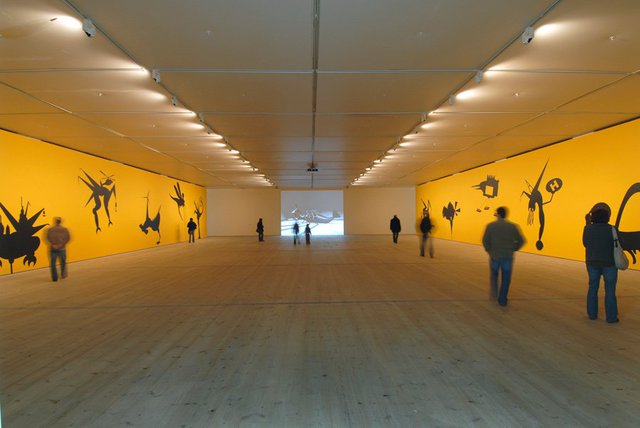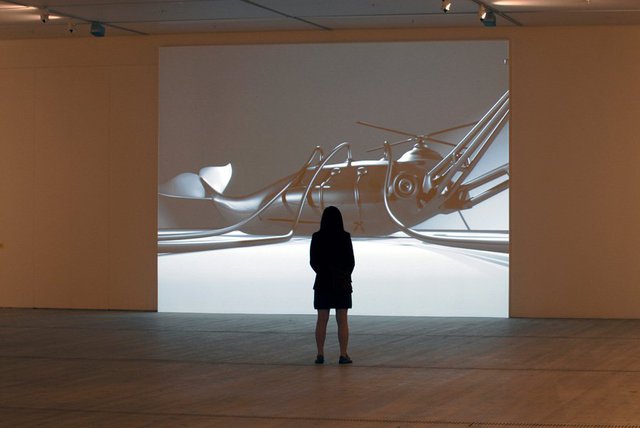Interviews
Object Study
Mona Marzouk in conversation with Aleya Hamza
Mona Marzouk's interest in architectural histories is visible in many of her works – in painting and sculpture as well as site-specific murals and paintings. Blurring the boundary between past and present day, man-made and natural, biomorphic and geometric, personal and political, beautiful and ugly, and masculine and feminine, Marzouk redefines how we see the world. With the sensibility of a maverick architect, Marzouk envisions aesthetic systems that draw on a diversity of cultural traditions but which can only exist in the realm of the imagination. Her early paintings and sculptures reassemble disparate architectural elements from history as well as animal and body parts to construct unified compositions. Castles and cathedrals, crenellations and crustaceans merge together in fluid form. Her compositions, which often float in the center of a frame, reference post-minimalism, with their hard edges and flat expanses of solid color. Her later works take on a more menacing quality. Strong saturated colors and the introduction of black replace a pale, bi-chromatic palette. Through imaginative studies of objects such as flags and helmets, Marzouk tackles politically loaded themes such as war, sports, nationhood, space technology and oil industry and how they habitually manifest themselves in our daily lives. With a whimsical touch, her work pulls us into a futuristic, mythological universe compelling us to forge unexpected relationships between what is otherwise familiar or ordinary.
Aleya Hamza: You studied at the Dusseldorf Art Academy, which is quite unusual. Most artists from your generation are either self-taught or studied at one of the Fine Art academies in Egypt. How did this happen, and were you trained as a painter and sculptor there?
Mona Marzouk: Initially, I enrolled at the Dusseldorf Academy at the end of 1992 as a guest student, to get into their system. Here in Egypt, the main difference between the early 90s and now is the availability of information and the presence of networks that allow connections to happen. Back in the early 90s there was none of that and you depended largely on bits of information here and there, whatever you could get your hands on to understand what was going on in the world. So when I got the chance to study abroad, I immediately chose the Dusseldorf Academy. Dusseldorf was the academy that I had read was the most exciting in the 80s, with teachers such as Joseph Beuys, Jannis Kounellis, and Nam Jun Paik. In Dusseldorf, I discovered my interest in architecture and the work of artists who were early influences on my work like Richard Artschwager, Magdalena Abakanowicz, and Donald Judd. I studied under a sculptor by the name of Christian Megert who always mixed 2D with 3D and blurred the boundaries between painting and sculpture in an exhibition environment and in public space. But I also attended classes by Nan Hoover, Kounellis and many others so my interests began widening and I started thinking in terms of painting as an expanded field.
AH: Your paintings represent the extreme of the non-painterly. The material surface is totally smooth, color is flat and solid and representations are hard-edged. In their execution, there is no room for chance. Can you talk about your position towards this tradition of painting?
MM: This is an extremely important question that has always preoccupied me. In a way my paintings are non-paintings. And as soon as you begin to think of painting in these terms the question of what defines the painterly becomes much more complex. Why? Because imagine if these works were mechanical or digital reproductions, wall posters for example. They definitely are not the same thing as the murals or the canvases. But on the other hand, my murals and canvases are definitely less painterly than most if not all hard-edge abstraction and similar schools of painting that disavow the painterly. In the works of these artists you could still see the 'touch' – the movement of the hand as it applies paint onto a surface. It's hard to notice that 'touch' in my work. I seek mechanical perfection yet I understand that I can only seek that while still using my own hands, and somewhere in this paradoxical space, an elusive residue of painting survives and allows for my work to be labeled as painting. I am interested in this unsettled position and the complications, questions, and possibilities it can bring up.
AH: You often exhibit sculpture and painting together. How do you see the relationship between them in your work?
MM: They feed off each other. It also has a lot to do with my early interest in architectural histories, details, plans etc. The connection between my paintings and sculptures was about exploring the ins and outs of these histories and details, in 2D and 3D, in space and on the wall, and through that creating a different relationship to architecture.
AH: Many of your works, particularly the acrylic on canvas paintings, have a similar composition. They are centered and contained in the picture frame, and they depict composite images, both of which lend the works an emblematic quality. Can you comment on that?
MM: I think this is connected to my interest in signs surrounding us in our daily environment and how they operate as signifiers for things we should or should not do. Such signs usually have to be set up in a certain way to separate the sign from reality while also making a meaning clear. I am interested in exploring the boundaries that this process (of producing signs) has to offer, how one can create something that operates in a similar way yet is completely different, and where the meaning is more complex
AH: The exhibition The New World (2006) marked a departure in your palette. You moved away from your signature pastels towards a darker, more saturated color scheme, and you began using black for your 'figures'. What produced this shift?
Before what you called the pastel-colored period, I was working with strong hues, bright reds, blues, greens, yellows and dark mixed colors. The shift to the pastels actually came when I had to solve the problem of not being able to ship paintings to exhibition spaces abroad and started making site-specific murals. This led to a concern with conditions of light in relation to space and surroundings: how can a mural reflect, absorb, and interpret light. I studied Turner's paintings back then and had a deep interest in Monet's haystacks and cathedral paintings in which he broke down light into color in endless variations. So again, the colors I used in that period were linked to an awareness of architecture, light, and nature. Around 2006, many of my interests had begun to change a little, taking a more politically conscious turn. I think this was probably what triggered the shift in palette from a light sensitive one to a more graphic one. But, this could all change in the near future. Color has to be associated to the project you are working on and your preoccupations at the time.
AH: The Bride Stripped Bare by Her Energy's Evil (2008), your solo show at the BALTIC Centre for Contemporary Art, Gateshead, was composed of two large-scale wall paintings, and an animation. This is the first and only video that you have presented. Can you tell us how this particular choice came about?
MM: Originally, I had wanted to produce sculptures for this project, in which some of the various elements (sometimes I call them characters – I am talking here about the individual forms that make up the whole work) in the mural would interact, but the plan changed when I saw the BALTIC Centre for Contemporary Art space. Each element (or character) in the mural's composition has its own set of references and its own world so to speak, but in the mural they appear as signs to something more multi-layered but unexplained. The expansive, almost cinematic space inspired this idea that I should use one wall to further examine the world of each element or character through a filmic experience, but the time and budget limitations meant that I could only do one character. The point behind this animation was inviting the audience to think of the possible worlds of each of these elements or characters.
AH: Your practice and methodology resembles that of an architect. Not only because it involves a long process of research, and planning, but also because in your work you often devise hypothetical and unified aesthetic systems. Can you talk a little about your methodology?
MM: I think methodology is too strong a word, it's like a discipline, and I am not that ordered. I have to be open to many influences and materials. It's really about making associations that can stimulate imagination, unexpected relationships, and about uncovering moments when connections happen that seem extraordinary yet natural at the same time. For example, in the Helmet series (2005) this was very clear. In other projects the connections are more complicated but in the end the process and the research that go into a project can be seen and felt through these connections.
AH: There is a whimsical quality to your paintings. Playfulness and humor can open up a space for engaging with a work especially if it deals with or depicts a loaded issue. How do you see this?
MM: I think this quality is unplanned, it just happens! I never really give it any thought or force it, so in a way it remains an unknown dimension in my work, something always unexpected, but I think some aspects of art making should remain unknown to the artist and public alike.
AH: You are currently working on a new body of work. What has been the point of departure for it?
MM: Yes, I am working on a new body of work. It takes the courtroom as its starting point. These past few years of demonstrations and political/social upheaval have been intense, and the courtroom as a space in these unfolding narratives caught my attention, as a space of so called justice, as a psychological space, as a space of argument, as a problematic construct. This led me to research cases of miscarriage of justice and wrongful convictions in different parts of the world, in the present and in history, and speculations about such cases in the future. I am working on developing and linking elements from such trials – evidence, phrases, and sentences – to make a body of work that I hope will disrupt the idea of justice.
Mona Marzouk was born in 1968 and lives and works in Alexandria, Egypt. After finishing her studies at the Academy of Fine Arts in Düsseldorf, Germany in 1996, Marzouk returned to her hometown of Alexandria, Egypt to launch her professional career in painting and sculpture. Selected solo exhibitions include The Bride Stripped Bare of her Energy's Evil, BALTIC Centre for Contemporary Art, Gateshead, UK (2008); The New World, Art in General, New York and Townhouse Gallery, Cairo; MUSAC, León, Spain (2006). Selected group exhibitions: Havana Biennial (2012); Second World: Where is Progress Progressing, Steirischer Herbst, Graz, curated by What, How & for Whom / WHW (2011); 8th Gwanju Biennale, curated by Okwui Enwezor (2008); 1st Canary Islands Biennale, Spain (2006). From 2005–2013, Marzouk co-founded and co-directed the artist-run space Alexandria Contemporary Arts Forum in Egypt.

















